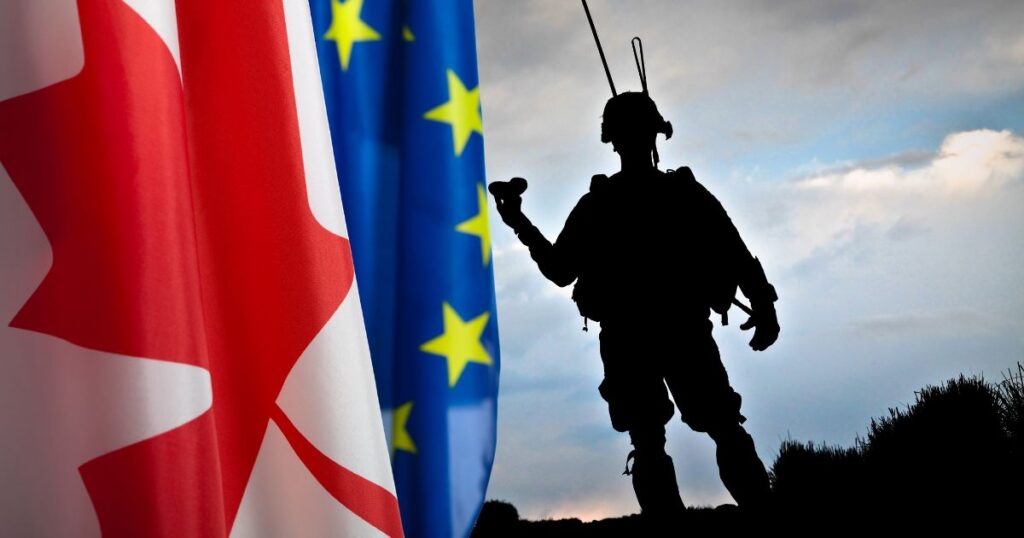On Monday 23 June 2025, in Brussels, Canadian Prime Minister Mark Carney and European Union leaders, including Commission President Ursula von der Leyen and Council President António Costa, will officially sign the “Canada–EU Security and Defence Partnership Agreement”. The agreement was defined, by an EU official, as one of the most ambitious that Europe has ever made with a non-EU partner, and provides for a wide range of political, industrial and military initiatives.
A multi-pronged security partnership
This is not a simple memorandum: the pact includes Canada’s participation in the European SAFE (Security Action for Europe) mechanism, a thirty-year, €150 billion program aimed at financing joint projects in the defense sector. Canada will be able to access tenders for supplies, co-development of military systems, and participate in joint exercises and training.
In concrete terms, the framework covers:
- Crisis management, with trained and interoperable task forces;
- Military mobility, to facilitate deployment and transport between continents;
- Maritime security, including anti-piracy and fleet control in international waters;
- Cyber defense, to counter digital attacks and protect sensitive infrastructures;
- Industrial cooperation, to integrate the supply chains of the defense sector
Why now, why together
The initiative was born in a dense geopolitical context: in Europe, the war in Ukraine has renewed the urgency of building an autonomous capability from NATO, while remaining within the framework of the Alliance. At the same time, Canada, while a historic member of the transatlantic context, has experienced instability with the United States in the recent past – the trade war and political tensions have prompted Carney to look for alternatives.
During the G7 in Kananaskis, Von der Leyen had already announced the agreement, calling Canada a “key partner” to strengthen “the European defence architecture”. For Carney, the signing of this security agreement is also a concrete step towards strategic autonomy, consistent with the recent commitment to bring Canadian military spending above 2% of GDP, as promised.
Regulatory framework and internal policy
To be operational, the security agreement will require final approval by the European Parliament and the Canadian Parliament. The regulatory dimension concerns both inclusion in the SAFE programme and tender procedures, as well as adherence to common guidelines on military mobility (customs formats, equipment, diplomatic passports) and on the sharing of security information.
On the Canadian side, the political opposition and some observers could raise questions about decision-making independence – in particular with respect to future choices on the export of military systems and their use – which do not always coincide with European needs.
Economic-industrial dimensions
For companies in the defense sector, the agreement causes a paradigm shift. In addition to access to European tenders, Canadian companies can collaborate on joint developments on drones, radars, naval systems and cybersecurity. Similarly, European industries will have a new market in Canada, with safety supply chains that will benefit from North American logistics and compatible industrial standards.
Linked to this is the SAFE project, which aims to ensure economies of scale and technological integration: Canadian involvement adds know-how and production capabilities, but at the same time imposes the need for agreements on interoperable standards.
Strategic implications
On the geopolitical level, the pact strengthens the Western position on security, along two lines.
- European autonomy: Canada’s involvement has a leverage effect on projects such as Readiness 2030 (formerly ReArM Europe), which aims to increase public and private defense funds up to €800 billion.
- North American diversification: Canada consolidates its ability to choose sources and partners in a more pragmatic way, reducing dependencies and vulnerabilities.
Critical issues and obstacles
However, there is no shortage of challenges:
- Decision-making coordination: coordinating the EU, Canada and NATO on timelines, objectives and rules could prove complex;
- External pressures: Washington will not fail to observe the evolution, also because the US arms industry will want to protect its share, and could exert political pressure on Ottawa;
- Legislative timeline: if the European parliament delays in ratifying, this could slow down Canada’s effective entry;
- Global contingencies: New developments – escalation in the Middle East, cooling relations with Russia or China – can shift priorities and resources.
After Monday’s signing, Brussels and Ottawa will enter a phase of operational implementation: bilateral negotiations between states to define Canada’s participation, openness to tenders, modalities of European participation in joint exercises.
In the meantime, Carney will continue his European tour: from Brussels, he will move to The Hague for the NATO summit, focused on strengthening the military spending target (the so-called 2% will go towards 5% of GDP).
On a strategic level, we can therefore read the agreement as a piece of a new transatlantic defence architecture – broader and more flexible. Canada embraces a long-term European dimension; the EU welcomes a non-EU strategic member, strengthening its capacities and legitimising SAFE as a global security programme.
Overall, the signing of this pact will be a clear political signal: the West intends to equip itself with diversified security networks, with allies who share vision and resources, to face rapidly evolving military and technological challenges.




